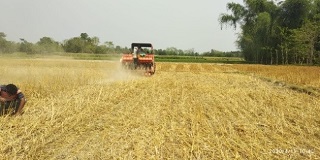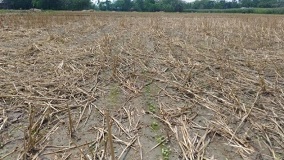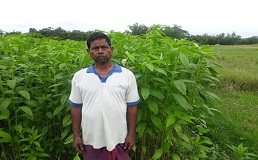The Jute, being one of the major cash crops grown in West Bengal, covers about 5.15 lakh hectare land and shares about three-fourth of the total production of the country. The Jute-Rice, a very popular cropping system in Terai Zone of West Bengal, is predominantly cultivated by the marginal and small farmers. The warm humid climate with occasional rainfall during pre-monsoon season in Terai Zone of the state is very suitable for the crop. But, the increased adoption of Rabi Maize has led the area under Jute to gradually decrease throughout the Terai region of the state. The control of fibre’s marketing by the middlemen deprives the farmers to get remunerative price.


Initiated in 2014-15, the scientists of Uttar Banga Krishi Viswavidyalaya (UBKV) in collaboration with the CIMMYT under an Australian Centre for International Agriculture Research (ACIAR) Funded Project entitled “Sustainable and Resilient Farming System Intensification in Eastern Gangetic Plains (SRFSI)” carried out several participatory trials on popularising the Conservation Agricultural (CA) practices in the various crops. It accordingly standardized the protocols for CA-Jute in 2017-18 and this protocol has been demonstrated successfully in various farmers’ fields over the region.


The active support of Department of Agriculture, Government of West Bengal and Satmile Satish Club and Pathagar (SSCOP), a local NGO working on agriculture, benefited the farmers with zero tillage technology in jute since last 2 to 3 years. It was very challenging to convince the farmers initially to trial jute crop without tillage operation using multi crop planter, but successful demonstration in their field attracted them to stick to this beneficial zero tillage technology particularly when the farmers desperately need some labour-reducing technologies under the current scenario of labour shortage.
With increased mechanization, the farmers also started using the combine harvester for the last couple of years. Its use in preceding wheat crop forced the farmer to go for burning for cleaning the field earlier to sow jute crop. Keeping the Happy Seeders’ benefits in mind, the UBKV’s scientists tried to calibrate it for jute seeding that was probably the first attempt in India to sow jute with it.
This year, the demonstrations were conducted over 10 acres of land involving 25 farmers from different Blocks of Coochbehar District. The local NGO, SSCOP was also addressing the problem of stubble mulching through a project supported by the DAP, Australian Consulate-General, Kolkata where the UBKV provided the technical backstopping. The selected farmers were already exposed to zero tillage technology and most of them were practicing it with multi-crop planters in jute also for the last two years. The technology showed that the cost of cultivation per acre could be restricted to Rs. 20,250.00 / acre which was Rs. 5,280.00 lesser than the conventional method. Even the use of Happy Seeder helped in saving Rs. 1,980.00 / acre over zero tillage technology using multi-crop planters.
The Happy Seeder technology in jute is bringing huge satisfaction to Hosenara Bibi, Bijay Roy, Ramen Barman, Bhabatoshpatwary and many more demonstrating farmers of Coochbehar in terms of good yields and higher profits along with significant positive effects on environmental impacts. Even under the COVID-19 Pandemic situation, the demonstration plots were visited by many nearby and distant jute farmers. The cost of cultivation has been substantially reduced in the technology which attracted many more farmers. The technology would reach to many jute farmers of the region with active support from the Government.
(Source: Uttar Banga Krishi Viswavidyalaya, West Bengal)








Like on Facebook
Subscribe on Youtube
Follow on X X
Like on instagram